Articles

LucasArts.com 20th Anniversary History Feature Part One: The Early Years, 1982 - 1989
This is the first of a four part history of LucasArts. This portion focuses on the company's origins, beginning in 1982 when video games were a new phenomenon. The information in this story is based on company documents, historical publications from other developers and publishers, and past and present employee recollections.
Overview
Back in 1982, computer games were relatively primitive, usually consisting of blocky objects that players manipulated against a black backdrop.
But George Lucas saw something more.
In much the same way as he had taken the black backdrop of space and grafted a rich, story-driven adventure onto it with Star Wars®, he saw potential to one day ignite the blackness of a computer monitor with epic, character-focused games.
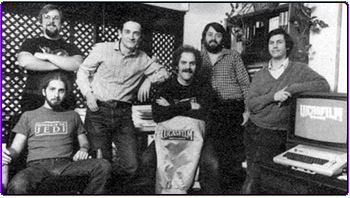
Thus, it was fitting that the Games Group of Lucasfilm came into existence in a non-descript office park, adjacent to a group that later became known as Pixar and right next door to Industrial Light & Magic (ILM), the company behind Star Wars' visual effects. Just as ILM was established to take visual effects to a new level, Lucas asked a small group of game designers, programmers, and artists to take games to the next level. This mission was clearly outlined in Lucasfilm's 1983 annual report: "The immediate goal is to find the best way to bring the 'Lucasfilm touch' to video games and help advance the state of the video game art."
Soon after its launch, the Games Group began research and development work to investigate the capabilities of the Atari 2600 and 5200 – that is, whenever they could pull themselves away from trying to break the 400,000 point barrier in Millipede.
Before long, what began as mere research turned into the company's first two games, Ballblazer® and Rescue on Fractalus!® Created in partnership with Atari and later published by Epyx, both games were officially introduced to the media in January 1984 during a press conference in which the Games Group was officially announced as Lucasfilm Games. That June, the games were unveiled publicly at the Summer Consumer Electronics Show.

First titles
- Ballblazer (March 1984, Atari 5200, Atari 800, later: Commodore 64, Apple II, PC, Amstrad, Sinclair Spectrum, Atari 7800)
- Rescue on Fractalus! (March 1984, Atari 5200, Atari 800, later: Commodore 64, Apple II, PC, Amstrad, Sinclair Spectrum, Atari 7800)
- Koronis Rift™ (December 1985, Commodore 64, Atari 800)
- The Eidolon™ (December 1985, Commodore 64, Atari 800)
- Labyrinth™: The Computer Game (1986, Commodore 64, Apple II)
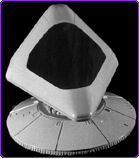
Ballblazer played like a futuristic version of Pong crossed with soccer. Strapped into a hovercraft-like Rotofoil, players battled opponents to snare a floating ball called a Plasmorb, which could then be fired or carried into the opponent's goal. The action on the field was augmented by the first interactive music in a game, which modified itself according to how the player was performing at any given time. Originally known as BallBlaster but later renamed, the game stayed true to George Lucas' vision of building unique interactive experiences.
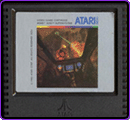
If the perils of trying to snatch and hold onto a floating orb weren't enough, players also could assume the controls of Rescue on Fractalus! which released at the same time as Ballblazer. Taking place on the harsh alien planet Fractalus, players piloted a Valkyrie Fighter, which was used to track down stranded space pilots. The search and rescue mission became more complicated once aliens, known as Jaggies, arrived to protect the planet. At this time the Computer Division was experimenting with the recent innovation of anti-aliasing, the technology now used to smooth out the edges of characters on a screen. The Games Group knew the game systems of the time would be unable to achieve that level of graphic quality, so they decided to make fun of their low-resolution graphics and name their aliens Jaggies. Once, the team even considered calling the game "Behind Jaggi Lines" as a pun because of the very jagged window struts that the player sees when looking out of the game's cockpit. The planet in the game, Fractalus, also got its name from a new technology: breakthrough realtime fractal generated imagery, which generated random landscapes and achieved a momentous frame rate of six to eight frames per second on the Atari.
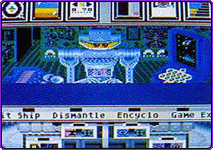
Following the launch of these first two games and a name change from the Games Group to Lucasfilm Games, the company quickly turned to developing another unique slate of titles. Koronis Rift, set in 2049, used an advanced version of the 3D fractal engine created for Rescue on Fractalus! In this futuristic adventure, players traveled to a distant planet in the hopes of salvaging superior weapons technology from abandoned space ships. While battling aliens and flying saucers, players sent out droids to acquire whatever technology remained inside these ships.
Technology also played a key roll in The Eidolon, a game named after a spherical shaped, human-sized globe that let its user venture into his or her own mind. After stepping into the Eidolon machine, players experienced a first-person fantasy role-playing game involving ten levels of cavernous mind tunnels. These twisting tunnels of players' psyches were populated by creatures such as trolls and dragons. If players were unable to destroy these guardians of the id, the Eidolon machine would run out of power, forcing the player to restart the level.
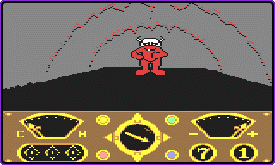
The programmers for The Eidolon wrote groundbreaking code that enabled characters to change size smoothly as they walked toward or away from the screen. This character scaling function gave the development team the ability to simulate depth on the screen and reuse the same art in different scenes. This code was later perfected and eventually used in the SCUMM (Script Creation Utility for Maniac Mansion) engine.
Up to this point, all of Lucasfilm Games's titles had stemmed from original concepts. That trend would change in 1986, when the group began to work on Labyrinth, a game inspired by the Jim Henson-directed film of the same name. George Lucas, the movie's executive producer, commissioned a game to be released alongside the film. The result was a maze-filled adventure where players were challenged to navigate through the lair of Jareth, the evil Goblin King. Technologically, Labyrinth was ahead of its time. A unique, pre-SCUMM "slot machine" text interface was developed to drive the game. Instead of typing in commands as most adventures of the day required, the player would choose a noun and a verb from vertical strips of words to instruct the game on what to do next.
Early Simulation Games
- PHM Pegasus™ (1986, Commodore 64, PC, Apple II)
- Strike Fleet™ (December 1987, PC, Commodore 64, Apple II)
- Battlehawks 1942® (October 1988, PC, Amiga, Atari ST)
- Their Finest Hour: The Battle of Britain® (October 1989, PC, Amiga, Atari ST)
Having successfully created an interesting mix of original games, Lucafilm Games began to look for new themes to explore. With game graphics rapidly evolving, a group inside the company turned their attention to the development of PHM Pegasus, a realistic naval simulation game. The game focused on combat involving the unique hydrofoil first built by the Navy in the 1970s. Published by Electronic Arts, PHM Pegasus was the first product from Lucasfilm Games to sell more than 100,000 copies. Not surprisingly, a sequel called Strike Fleet was soon put into development. Strike Fleet was a more tactical game, requiring players to control up to eight warships, from hydrofoils up to cruisers, in locations such as the Persian Gulf and Falkland Islands. Some have called this the first real-time strategy game.
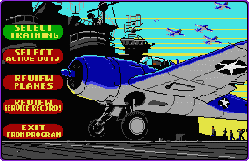
Flush with the success of the naval simulation products, Lucasfilm Games turned its interest from the sea to the sky. Battlehawks 1942 would become the first in a well-known trilogy of World War II air combat simulators. In Battlehawks, players piloted six classic American and Japanese warplanes during four pivotal air battles in the Pacific theater. The game was heralded by critics and fans because of its historical accuracy. In fact, the game's manual was more than 150 pages and filled with archived photos and detailed information about each plane. Historians also appreciated that the game looked at a pivotal part of the war from both sides. Battlehawks was the first flight simulator that let players replay battles and step in to control them from any point. Following Battlehawks was Their Finest Hour: The Battle of Britain, the second WWII simulator that featured English and German warplanes dogfighting above the English coastline.
These simulation titles quickly became fan favorites, setting the stage for classic LucasArts games in the early 1990s such as Secret Weapons of the Luftwaffe® and Star Wars: X-Wing®.
Original Adventures
- Maniac Mansion® (October 1987, IBM, Amiga, Atari ST, Commodore 64, Apple II, NES)
- Zak McKracken and the Alien Mindbenders® (October 1988, Commodore 64, PC, Amiga, Atari ST, Fujitsu FM Towns, Apple II)
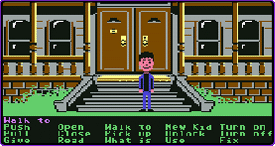
The creative-types inside of Lucasfilm Games would soon have ample opportunity to flaunt their zany senses of humor. Indeed, the October 1987 release of Maniac Mansion was a milestone for the company, as it faithfully captured the group's clever sense of humor and paved the way for future adventure games.
Created in just over a year, Maniac Mansion told the story of Dave, a high school student who, along with his friends, attempted to save his girlfriend Sandy from the clutches of Dr. Fred, a mad scientist who inhabited a Victorian mansion. Chock full of irreverent puzzles and wild one-liners, Maniac Mansion included a variety of possible endings and let players control multiple characters. The game was also the first adventure title to include cutscenes, non-interactive story sequences that soon became a common way to advance the plot of an adventure.
One of Maniac Mansion's most lasting contributions came in the form of its story engine, given the name SCUMM (Script Creation Utility for Maniac Mansion). SCUMM pioneered a new kind of graphic adventure interface. Previously, players typically had to type in commands -- such as GO NORTH or OPEN DOOR -- in order to progress through an adventure game. SCUMM eliminated the need to type in commands. Instead, players selected a verb on screen and then performed actions by clicking that verb on in-game objects. The new interface, heralded by both players and critics alike, became the basis for all future LucasArts adventures.
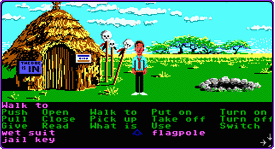
Lucasfilm Games's second foray into original adventure games stemmed from another inventive concept. The plot of Zak McKracken and the Alien Mindbenders was concisely stated on the front of the game box: "Can One Hack Writer, Two Yale Coeds, and a Stale Loaf of French Bread Save the World from a Galactic Conspiracy?" Players were cast in the role of a tabloid journalist who discovers a conspiracy among aliens to render humans terminally stupid. And yes, somewhere along the way Elvis is discovered to be living among the aliens. Using the SCUMM engine, Zak McKracken also featured the most extensive music and audio library of any product of its time, largely because one of the game's co-designers was a musician.
A Sign of Things To Come
- Pipe Dream® (a.k.a. Pipe Mania) (June 1989, PC, Macintosh, Apple II, Amiga, Atari ST, Commodore 64)
- Indiana Jones® and the Last Crusade™ - The Graphic Adventure (July 1989, PC, Amiga, Atari ST, Macintosh, FM Towns, CDTV)
- Indiana Jones and the Last Crusade - The Action Game (1989 - PC, Amiga, Atari ST, Commodore 64, Spectrum, GameBoy, NES, Genesis, SMS)
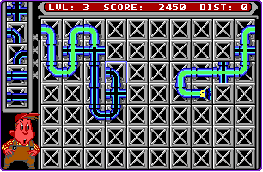
The late 1980s would bring about a number of milestones for Lucasfilm Games. While the company had been hugely successful in the simulation and adventure genres, it still made time to explore the unusual. One such title was Pipe Dream, a fast-paced spatial puzzle and strategy game in which players attempted to construct a pipeline with assorted plumbing parts. The construction process was complicated by toxic sewage that slowly made its way through the pipeline. If the sewage leaked, the game was over.
It was fitting that the last Lucasfilm game in the 1980s would signal the company's first step toward working extensively with one of George Lucas' motion picture properties. Indiana Jones and the Last Crusade (The Graphic Adventure) was intended to release simultaneously with the movie of the same name. Of course, shipping a game to meet the movie release date was easier said than done, especially since the developers only had nine months to complete the product. The game hit the shelves in July of 1989 while the movie was still playing in theaters.
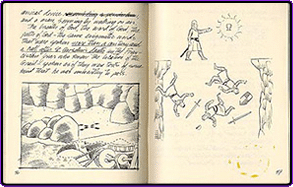
The SCUMM game engine came in handy as the team attempted to build the Indiana Jones game in such a short amount of time. The game's plot mirrored the movie's tale of Indy's search for the Holy Grail, spanning locations such as Venice and Berlin. Gameplay blended adventure game puzzles with fight sequences and labyrinth-like mazes. The design team, however, disagreed with how to end the game. As a result of this friendly dispute, the team decided to write multiple game endings, one humorous and one serious. A random number generator ensured that each ending would result roughly 50 percent of the time.
LucasArts also partnered with several other companies to produce an action version of Indiana Jones and the Last Crusade to release on many platforms through the years.
The balance between original games, such as Maniac Mansion, with licensed titles, such as Indiana Jones and the Last Crusade, served as a shining example of Lucasfilm Games' future. Moving forward, the company planned to continue developing inventive new titles, while also beginning to further explore George Lucas' rich movie universes. In the early 1990s, this approach would lead to a series of classic products, including the first Star Wars titles developed directly by Lucasfilm Games.